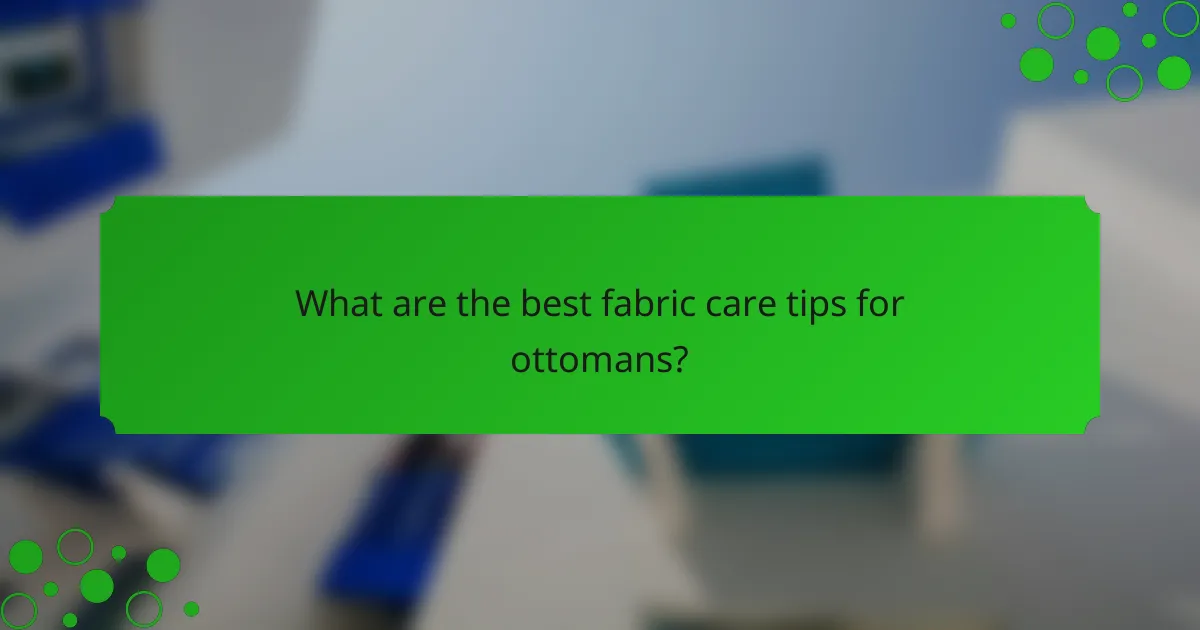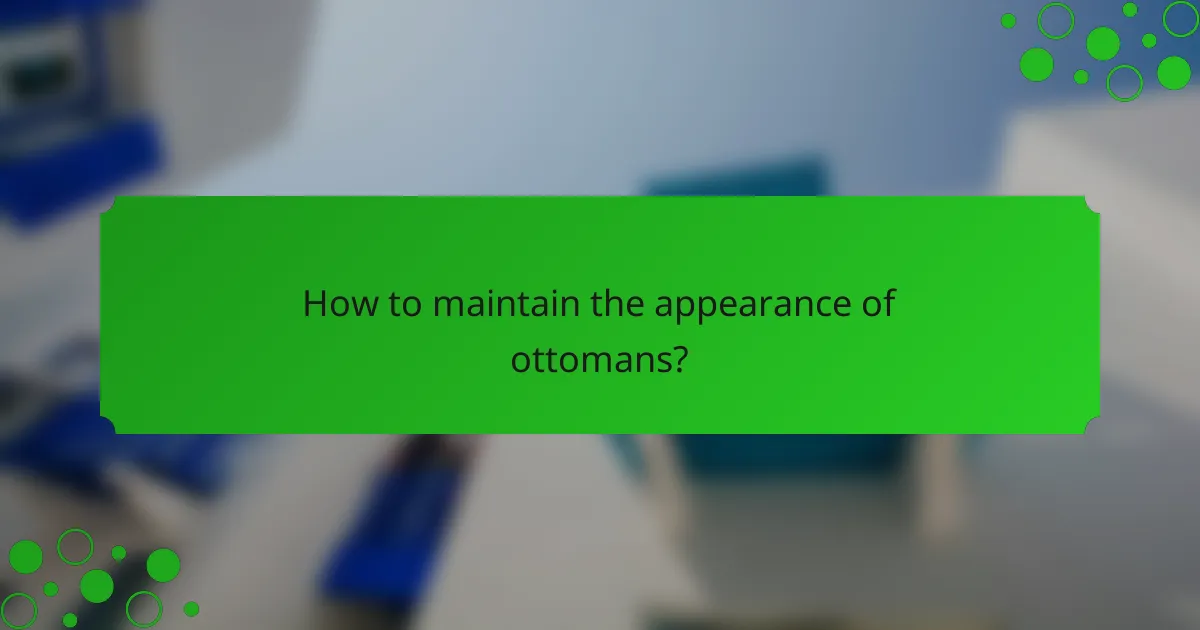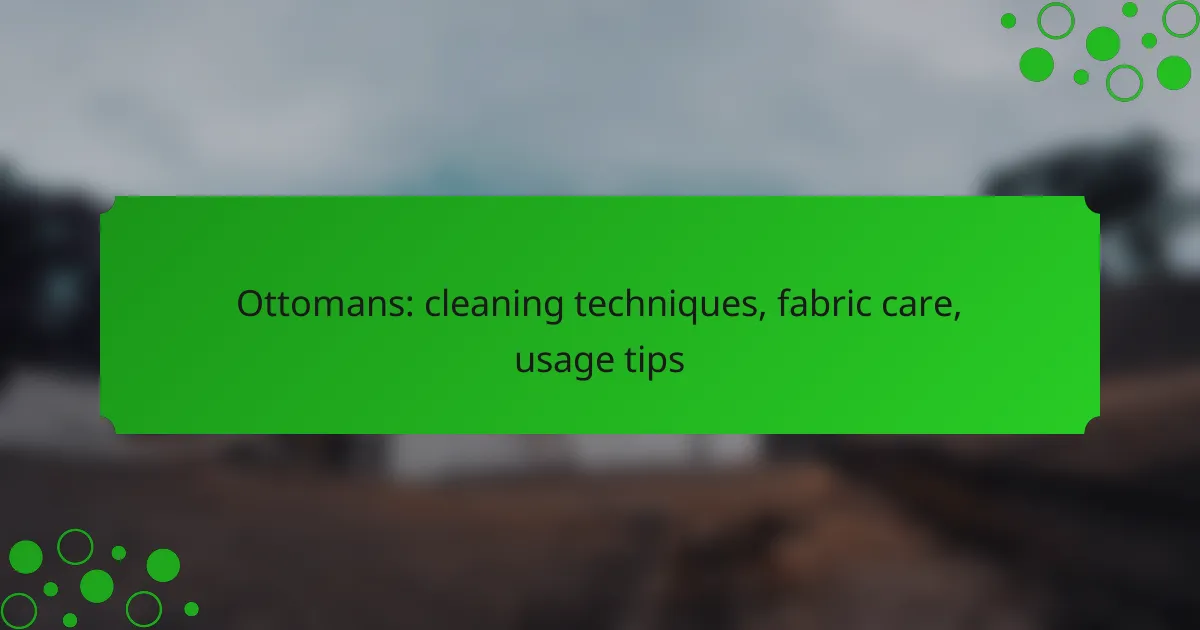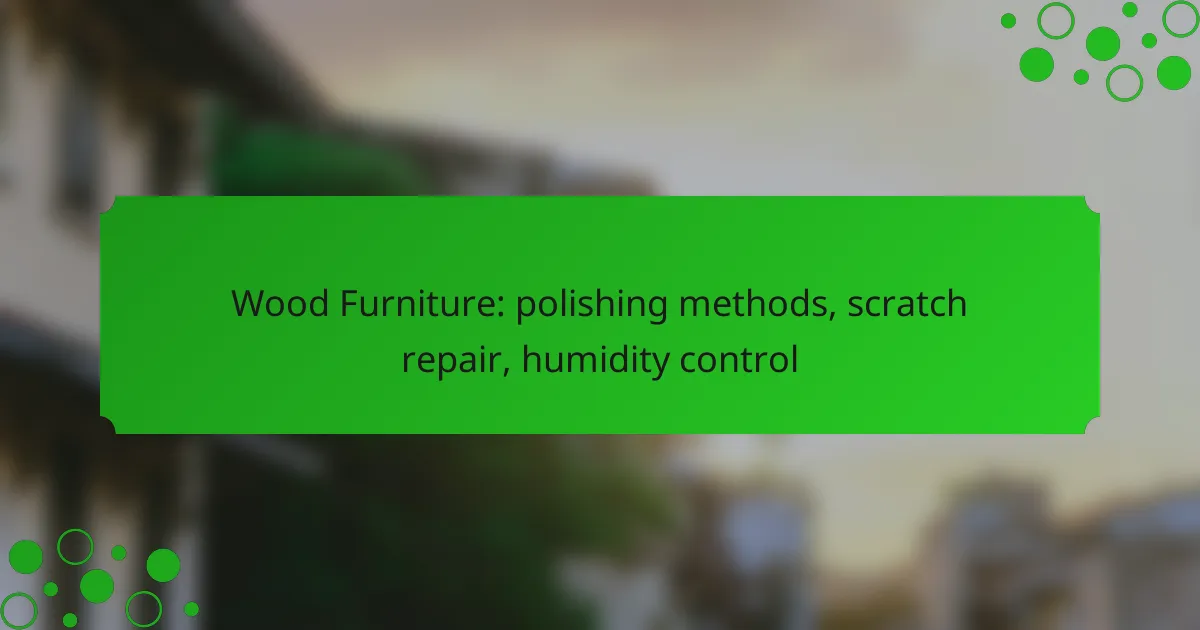Proper cleaning and care of ottomans are crucial for maintaining their appearance and extending their lifespan. By employing specific cleaning techniques tailored to the fabric type, along with regular maintenance and prompt stain treatment, you can keep your ottoman looking fresh. Additionally, managing sunlight exposure and moisture can further enhance its durability and overall look.

How to clean ottomans effectively?
Cleaning ottomans effectively involves a combination of regular maintenance and targeted cleaning techniques. By using appropriate methods for the specific fabric type, you can keep your ottoman looking fresh and prolong its lifespan.
Vacuuming techniques
Regular vacuuming is essential for maintaining the cleanliness of your ottoman. Use a vacuum cleaner with an upholstery attachment to gently remove dust, dirt, and debris from the surface and crevices. Aim to vacuum your ottoman at least once a week to prevent buildup.
When vacuuming, pay special attention to seams and folds where dirt tends to accumulate. For delicate fabrics, consider using a brush attachment to avoid damage while still effectively removing particles.
Spot cleaning methods
Spot cleaning is crucial for addressing stains on your ottoman promptly. Begin by blotting the stain with a clean, dry cloth to absorb excess liquid. Then, use a mild detergent mixed with water to gently dab the affected area, avoiding excessive scrubbing which can damage the fabric.
Always test any cleaning solution on a hidden area first to ensure it does not discolor the fabric. For tougher stains, consider using a fabric-specific stain remover, following the manufacturer’s instructions closely.
Steam cleaning guidelines
Steam cleaning can be an effective method for deep cleaning your ottoman, especially for fabrics that can withstand moisture. Use a steam cleaner with a fabric attachment, ensuring the steam is not too hot to avoid damaging the material.
Before steam cleaning, vacuum the ottoman thoroughly to remove loose dirt. After steaming, allow the fabric to dry completely to prevent mold and mildew growth. Check the manufacturer’s guidelines to confirm that steam cleaning is suitable for your ottoman’s fabric type.
Professional cleaning services
If your ottoman requires a deep clean or has stubborn stains, consider hiring professional cleaning services. These experts have access to specialized equipment and cleaning solutions tailored to different fabric types.
When selecting a service, look for companies that have experience with upholstery cleaning and check reviews for customer satisfaction. Be sure to inquire about their cleaning methods to ensure they are safe for your ottoman’s material.

What are the best fabric care tips for ottomans?
To maintain the appearance and longevity of ottomans, it is essential to follow specific fabric care tips tailored to the material. Regular cleaning, prompt stain treatment, and protective measures can significantly enhance the durability and look of your ottoman.
Fabric-specific care instructions
Different fabrics require unique care approaches. For example, leather ottomans should be wiped with a damp cloth and conditioned regularly to prevent cracking. In contrast, upholstered ottomans made from synthetic fibers can often be cleaned with mild soap and water.
Natural fabrics like cotton or linen may need more delicate handling, such as using a soft brush or vacuuming to remove dust. Always check the manufacturer’s label for specific cleaning recommendations to avoid damage.
Stain removal techniques
For effective stain removal, act quickly to prevent stains from setting. Blot the stain with a clean cloth instead of rubbing, which can spread the stain. For water-based stains, a mixture of mild detergent and water can be effective.
For tougher stains, such as oil or ink, consider using specialized cleaners designed for your ottoman’s fabric. Always test any cleaner on a hidden area first to ensure it does not discolor the fabric.
Protective treatments
Applying a fabric protector can help repel stains and spills, making maintenance easier. Look for products specifically designed for the type of fabric your ottoman is made from, as they provide a barrier without altering the material’s appearance.
Regularly reapplying these protective treatments, especially after cleaning, can prolong the life of your ottoman. Additionally, consider using coasters or trays on top of your ottoman to prevent scratches and spills from everyday use.

How to maintain the appearance of ottomans?
To maintain the appearance of ottomans, regular cleaning and care are essential. This involves routine maintenance, managing sunlight exposure, and controlling moisture to prevent damage and prolong their lifespan.
Regular maintenance routines
Establishing a regular maintenance routine is crucial for keeping ottomans looking their best. Vacuuming the fabric weekly helps remove dust and debris, preventing them from settling into the fibers. For spot cleaning, use a mild detergent mixed with water and a soft cloth to treat stains promptly.
Consider using fabric protectors designed for upholstery to repel spills and stains. Always test any cleaning solution on a hidden area first to ensure it does not damage the fabric.
Sunlight exposure management
Limiting sunlight exposure is vital for preserving the color and integrity of ottomans. Direct sunlight can cause fabrics to fade and degrade over time. Position ottomans away from windows or use curtains and blinds to shield them from harsh sunlight.
If your ottoman is frequently exposed to sunlight, consider using UV-protective sprays that can help minimize fading. Regularly rotating the ottoman can also help ensure even wear and exposure.
Moisture control tips
Controlling moisture is essential to prevent mold and mildew growth on ottomans. Keep the humidity levels in your home between 30% and 50% to create an environment that is less conducive to moisture-related issues. Using a dehumidifier in damp areas can be beneficial.
When cleaning, avoid soaking the fabric and ensure it dries completely afterward. If spills occur, blot them immediately with a dry cloth to absorb excess moisture, and allow the area to air dry thoroughly.

What are common ottoman usage tips?
Ottomans are versatile pieces of furniture that can serve multiple purposes in your home. They can function as footrests, extra seating, or even storage solutions, making them a valuable addition to any living space.
Multi-functional uses
Ottomans can be used in various ways, enhancing their practicality. They can serve as coffee tables when topped with a tray, providing a stable surface for drinks and snacks. Additionally, many ottomans come with hidden storage, allowing you to keep blankets, magazines, or toys neatly tucked away.
Consider using an ottoman as a makeshift seating option during gatherings. Their soft surfaces make them comfortable for short-term use, especially in smaller spaces where traditional seating may be limited.
Placement recommendations
When placing an ottoman, consider its proximity to seating areas. Ideally, it should be within arm’s reach of sofas or chairs to facilitate easy access. A good rule of thumb is to leave about 18 inches between the ottoman and other furniture to ensure comfortable movement.
In larger rooms, group ottomans with other seating to create a cohesive look. They can also be positioned in entryways for a convenient spot to sit while putting on or taking off shoes.
Styling suggestions
To enhance your decor, choose an ottoman that complements your existing color scheme and style. For a modern look, opt for sleek designs with neutral fabrics, while a vintage space may benefit from a patterned or textured ottoman.
Accessorizing your ottoman can elevate its appearance. Consider adding a decorative tray with candles or books on top, or draping a cozy throw blanket over it for added warmth and style.

What factors to consider when choosing an ottoman?
When choosing an ottoman, consider its size, shape, material, and functionality to ensure it fits well within your space and meets your needs. Additionally, think about how it complements your existing decor and whether it serves a practical purpose, such as storage or extra seating.
Size and space considerations
Size is crucial when selecting an ottoman, as it should harmonize with your room’s dimensions and existing furniture. Measure the available space to ensure the ottoman fits comfortably without obstructing pathways or crowding the area.
For smaller rooms, opt for compact ottomans that can double as coffee tables or storage solutions. In larger spaces, you might consider oversized options that can serve as statement pieces or additional seating during gatherings.
As a general guideline, leave at least 18 inches of space between the ottoman and surrounding furniture to allow for easy movement. This ensures functionality while maintaining a visually appealing layout.










